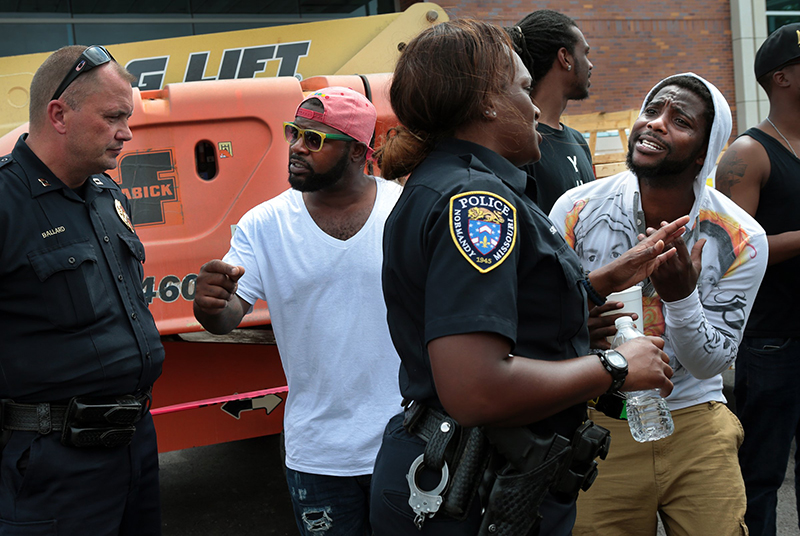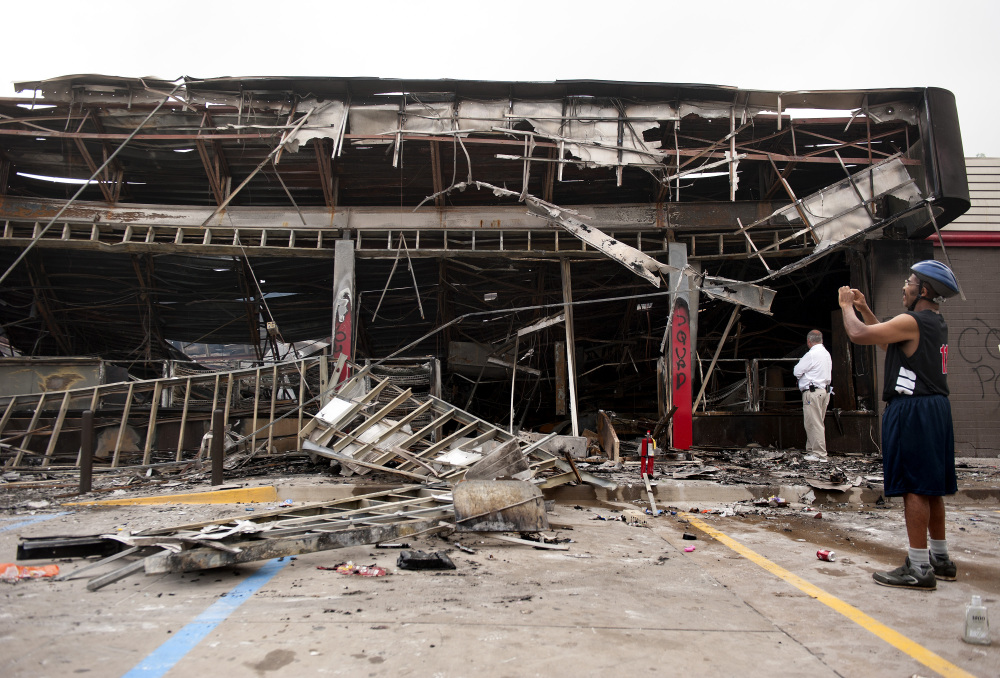FERGUSON, Mo. – A black teenager who was fatally shot by a police officer had his hands raised when the officer approached with his weapon drawn and fired repeatedly, according to two men who said they witnessed the shooting that sparked two nights of unrest in suburban St. Louis.
The FBI opened an investigation Monday into the death of 18-year-old Michael Brown, who police said was shot multiple times Saturday after being confronted by an officer in Ferguson, a suburb of 21,000 that’s nearly 70 percent black.
Authorities in Ferguson used tear gas and rubber bullets to try to disperse a large crowd Monday night that had gathered at the site of a burned-out convenience store damaged a night earlier, when many businesses in the area were looted.
Police Chief Tom Jackson said members of the crowd threw rocks at police and gunfire came from the crowd, so officers used tear gas and shot “beanbag rounds” meant to stun them.
An Associated Press photographer said police were telling people to go home, but authorities had blocked exit streets off. Jackson said police blocked off the area where most of the looting and vandalism occurred the previous night out of concern that cars passing by might hit demonstrators in the street.
Authorities were vague about exactly what led the officer to open fire on Brown, except to say that the shooting was preceded by a scuffle of some kind with a man. It was unclear whether Brown or the man he was with was involved in the altercation.
Investigators have refused to publicly disclose the race of the officer, who is now on administrative leave. But Phillip Walker said he was on the porch of an apartment complex overlooking the scene when he heard a shot and saw a white officer with Brown on the street.
Brown “was giving up in the sense of raising his arms and being subdued,” Walker told The Associated Press on Monday. The officer “had his gun raised and started shooting the individual in the chest multiple times.” The officer then “stood over him and shot him” after the victim fell wounded.
Dorian Johnson offered a similar account when he told KMOV-TV that he and Brown were walking home from a convenience store when a police officer told them to get out of the street and onto the sidewalk. Johnson said they kept walking, which caused the officer to confront them from his car and again after getting out of the vehicle.
Johnson said the first time the officer fired, he and Brown got scared and ran away.
“He shot again, and once my friend felt that shot, he turned around and put his hands in the air, and he started to get down,” Johnson said. “But the officer still approached with his weapon drawn and fired several more shots.”
“We wasn’t causing harm to nobody,” Johnson said. “We had no weapons on us at all.”
Walker said that he did not see a scuffle or the circumstances that preceded the first gunshot.
The St. Louis County Police Department refused to discuss Johnson’s remarks, citing the ongoing investigation. But county Police Chief Jon Belmar previously said that an officer encountered Brown and another man outside an apartment complex, and that one of the men pushed the officer into his squad car and they struggled over the officer’s weapon.
Ferguson Police Chief Tom Jackson said there’s no video footage of the shooting from the apartment complex or from any police dashboard cameras or body-worn cameras that the department recently bought but has not yet put to use.
Brown’s parents and their attorneys asked the public to share any information and videos they might have related to the shooting.
The family had planned to drop their son off at a technical college Monday to begin his studies.
“Instead of celebrating his future, they are having to plan his funeral,” said Benjamin Crump, a family attorney who also represented Trayvon Martin’s relatives after he was slain in 2012 in Florida.
“I don’t want to sugarcoat it,” Crump added. Brown “was executed in broad daylight.”
Crump and some civil rights leaders drew comparisons between Brown’s death and that of Martin and other young black men killed in racially charged incidents.
Brown’s mother, Lesley McSpadden, said she did not understand why police did not subdue her son with a club or stun gun. She said the officer involved should be fired and prosecuted, adding that “I would like to see him go to jail with the death penalty.”
The FBI is looking into possible civil rights violations, said Cheryl Mimura, a spokeswoman for the agency’s St. Louis field office.
Attorney General Eric Holder said in a statement that the case deserves a full review.
Nearly three dozen people were arrested following a candlelight vigil Sunday night after crowds looted and burned stores, vandalized vehicles, assaulted and threatened reporters and taunted officers.
Deanel Trout, a 14-year resident of Ferguson, was convinced the troublemakers were largely from outside Ferguson and that they used Brown’s death and the vigil as an opportunity to steal.
“I can understand the anger and unrest, but I can’t understand the violence and looting,” Trout said.
Some people climbed atop police cars as officers with riot shields and batons stood stoically nearby, trying to restrict access to the most endangered areas.
Thirty-two people were arrested, police said. Two officers suffered minor injuries. There were no reports of civilians hurt.
On Monday, the scene of the shooting was marked with a makeshift memorial of candles and signs in the middle of the narrow street where Brown fell dead.
Brown’s father, also named Michael Brown, visited the memorial Monday, at one point straightening a wooden cross. He abruptly left after gunshots rang out a block away. There were no reports of injuries from that gunfire.
The person who was with Brown has not been arrested or charged, and it was not clear if he was armed, Jackson said. Blood samples were taken from Brown and the officer for toxicology tests, which can take weeks to complete.
Send questions/comments to the editors.














Comments are no longer available on this story